Walter Zibusiso Ncube
Predictive and Proactive Power Allocation For Energy Efficiency in Dynamic OWC Networks
May 03, 2025



Abstract:Driven by the exponential growth in data traffic and the limitations of Radio Frequency (RF) networks, Optical Wireless Communication (OWC) has emerged as a promising solution for high data rate communication. However, the inherently dynamic nature of OWC environments resulting from user mobility, and time-varying user demands poses significant challenges for enhanced and sustainable performance. Energy efficiency (EE) is a critical metric for the sustainable operation of next generation wireless networks. Achieving high EE in dynamic OWC environments, especially under time-varying user distributions and heterogeneous service requirements, remains a complex task. In this work, we formulate a discrete-time EE optimisation problem in a dynamic OWC to maximise energy efficiency through determining user connectivity and power allocation. Solving this problem in real time is computationally demanding due to the coupling of user association and power allocation variables over discrete time slots. Therefore, we propose a Probabilistic Demand Prediction and Optimised Power Allocation (PDP-OPA) framework which predicts user arrivals, departures, and traffic demands. Based on these predictions, the framework proactively determines AP-user associations and allocates power dynamically using a Lagrangian-based optimisation strategy. Simulation results demonstrate that the proposed PDP-OPA significantly enhances system performance, providing solutions close to the optimal ones. The proposed framework improves energy efficiency, sum rate, and bit error rate (BER) compared to distance-based user association and uniform power allocation, validating its effectiveness for real time and adaptive resource management in dynamic OWC systems.
ANN-Driven Adaptive Power Allocation for OWC
Apr 06, 2025Abstract:Vertical-cavity surface-emitting lasers (VCSELs) have gained popularity in Optical Wireless Communication (OWC) due to their high bandwidth and directional beam compared to Light-emitting diodes (LEDs). In this work, we explore the deployment of VCSELs as Access Points (APs) in an indoor environment with time-varying user distributions and traffic demands. To enhance performance, a merged access point (MAP) topology is introduced to extend the serving area of each cell using Zero Forcing (ZF) for interference management. A power allocation optimisation problem is formulated aimed at maximising the sum rate of the dynamic network. Deterministic approaches can solve the formulated problem but are impractical for real-time scenarios. In this work, we propose an Artificial Neural Network (ANN) for adaptive power allocation with reduced computational complexity. Our results show that the designed ANN learns and effectively provides instantaneous solutions in dynamic scenarios, resulting in improved performance in terms of sum rate compared to a baseline uniform power allocation scheme.
Intelligent Reflecting Surfaces assisted Laser-based Optical Wireless Communication Networks
Apr 02, 2024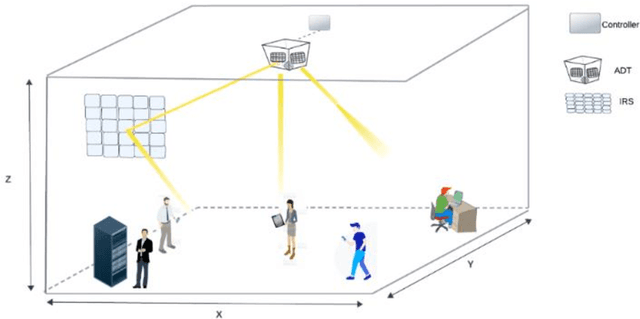
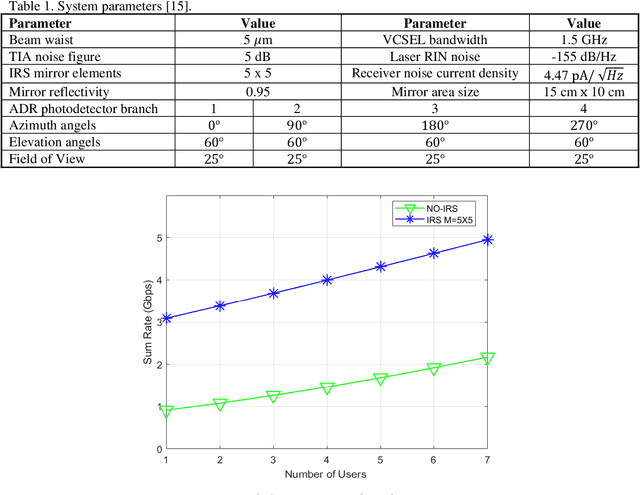
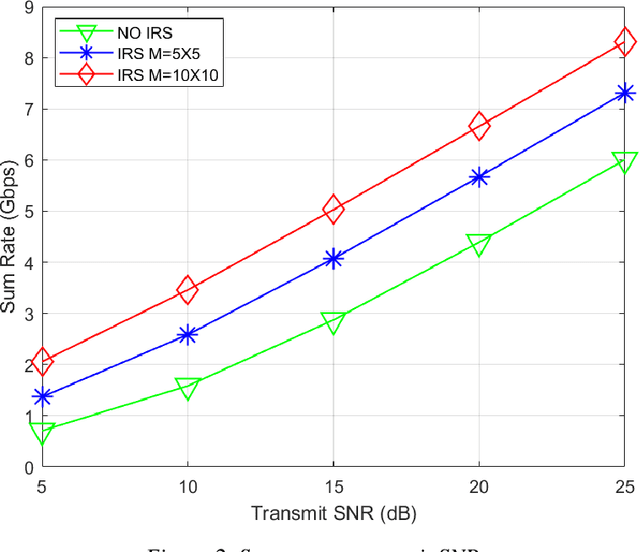
Abstract:The increasing demand for wireless networks of higher capacity requires key-enabling technologies. Optical wireless communication (OWC) arises as a complementary technology to radio frequency (RF) systems that can support high aggregate data rates. However, OWC systems face some challenges including beam-blockage. Intelligent reflecting surfaces (IRSs) can offer alternative pathways for the optical signal, ensuring continuous connectivity. In this work, we investigate the potential of using IRS in an indoor OWC network. In particular, we define a system model of indoor OWC that employs IRS in conjunction with angle diversity transmitters (ADT) using vertical-cavity surface-emitting laser (VCSEL) arrays. The VCSEL beam is narrow, directed, and easy to block, however, it can deliver high data rates under eye safety regulations. Simulation results show that the deployment of IRS can significantly improve the achievable data rates of Laser-based OWC systems.
Energy Efficient Laser-Based Optical Wireless Communication Networks
Apr 07, 2023Abstract:Rising data demands are a growing concern globally. The task at hand is to evolve current communication networks to support enhanced data rates while maintaining low latency, energy consumption and costs. To meet the above challenge, Optical Wireless Communication (OWC) technology is proposed as a solution to complement traditional Radio Frequency (RF) based communication systems. Recently, Vertical Cavity Surface Emitting Lasers (VCSELS) have been considered for data transmission in OWC indoor environments due to their ability to transmit power through narrow, near-circular beams to receivers. In this paper, we study the energy efficiency of a VCSEL-based OWC system in an indoor environment and compare it to that of a Light Emitting Diode (LED) based system. The main findings show that the VCSEL system performs better and has higher energy efficiency.
On the energy efficiency of Laser-based Optical Wireless Networks
Mar 21, 2022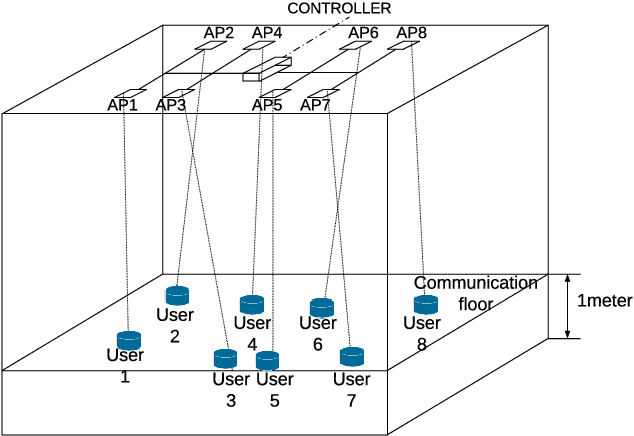
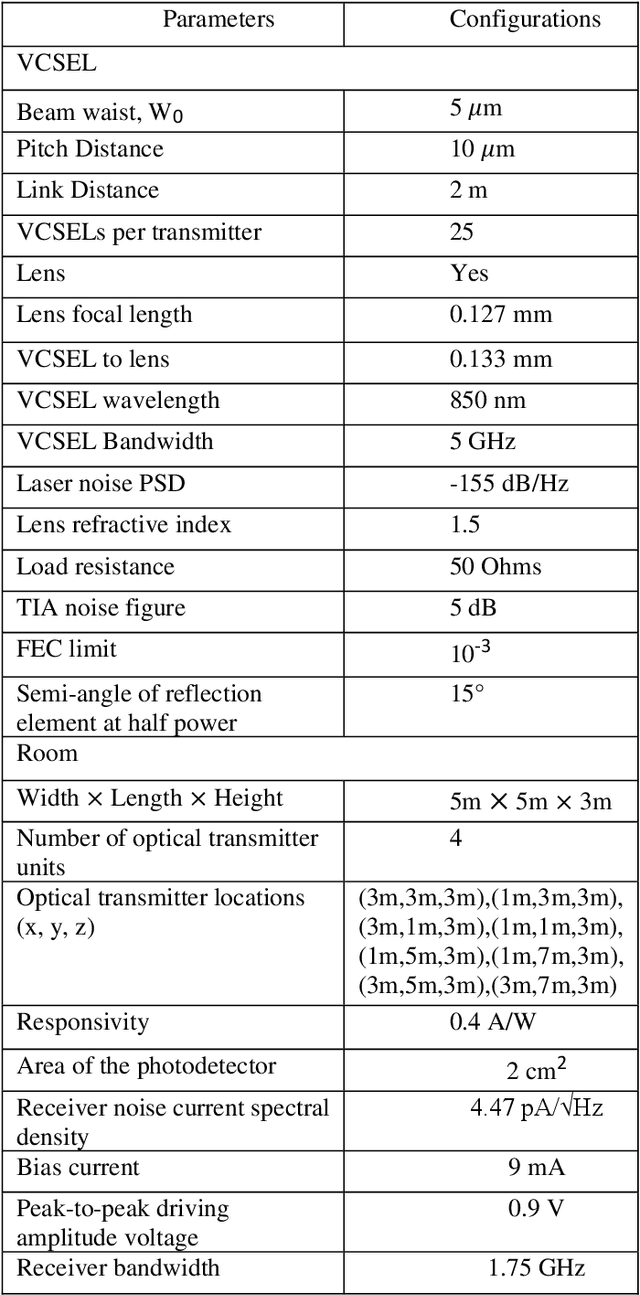
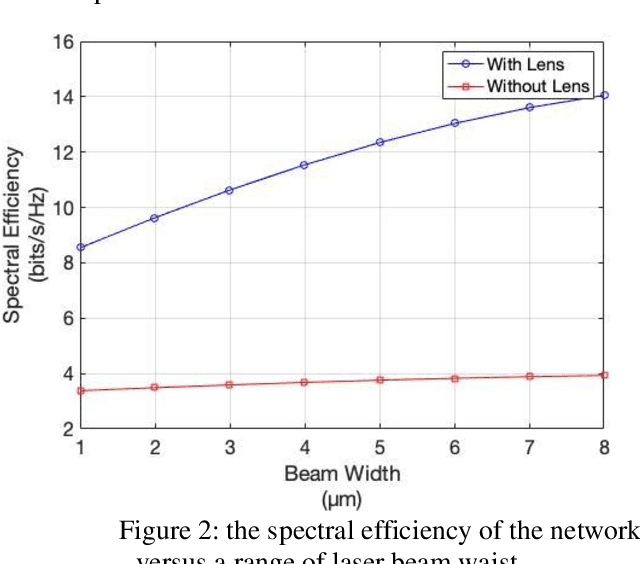
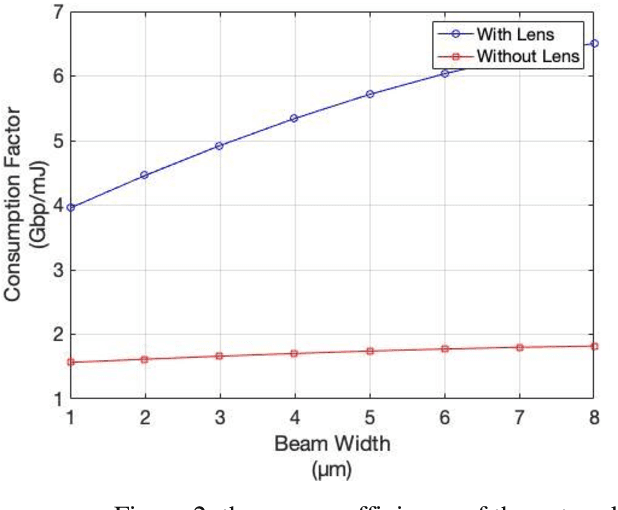
Abstract:Optical wireless Communication (OWC) is a strong candidate in the next generation (6G) of cellular networks. In this paper, a laser-based optical wireless network is deployed in an indoor environment using Vertical Cavity Surface Emitting Lasers (VCSELS) as transmitters serving multiple users. Specifically, a commercially available low-cost VCSEL operating at 850nm wavelength is used. Considering the confined coverage area of each VCSEL, an array of VCSELs is designed to transmit data to multiple users through narrow beams taking into account eye safety regulations. To manage multi-user interference (MUI), Zero Forcing (ZF) is implemented to maximize the multiplexing gain of the network. The energy efficiency of the network is studied under different laser beam waists to find the effective laser beam size that results in throughput enhancement. The results show that the energy efficiency increases with the laser beam waist. Moreover, using micro lenses placed in front of the VCSELs leads to significant increase in the energy efficiency.
 Add to Chrome
Add to Chrome Add to Firefox
Add to Firefox Add to Edge
Add to Edge